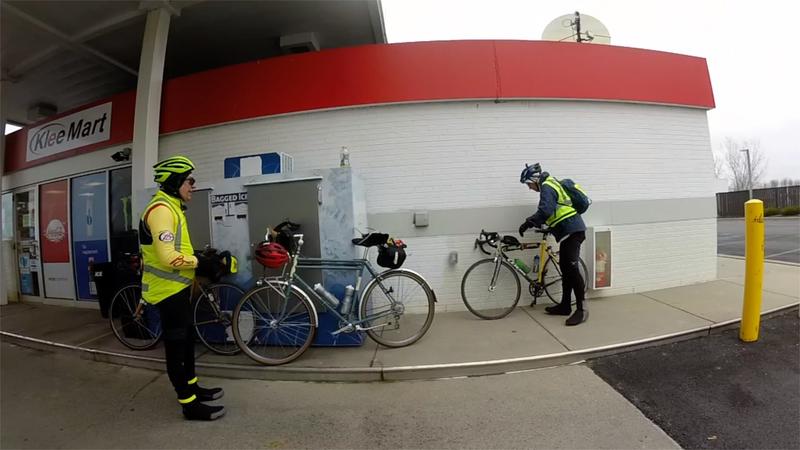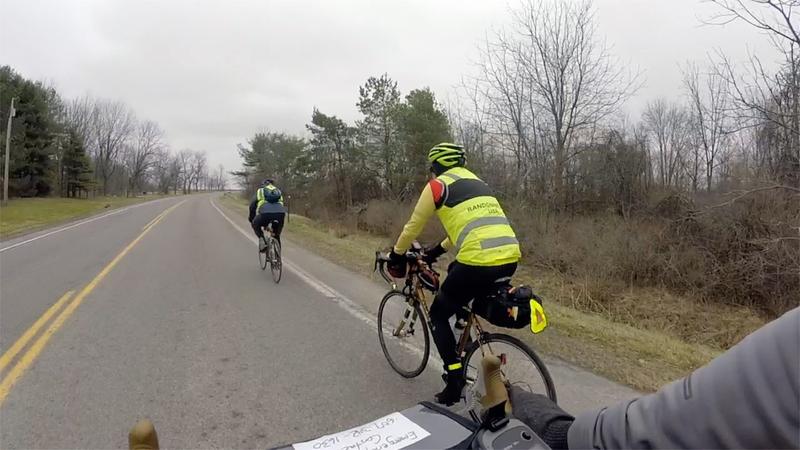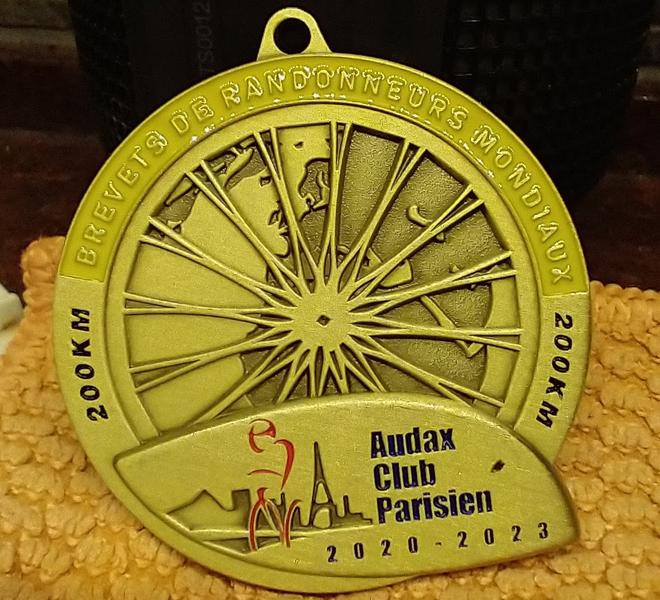 A typical spring NY farmfield.
A typical spring NY farmfield.
An Early Spring Ride
When I think of the best places in New York State to experience the outdoors, a few geographic regions such as the Adirondacks, the Catskills, the Finger Lakes, the Southern Tier, the Hudson Valley spring to mind. Rarely, if ever, do I consider a visit to the area north of the Thruway as a destination to spend 11 1/2 hours. Yet, I spent all of my daylight hours precisely like that on an early spring randonnée through the farmlands and around small towns east of Rochester, west of Syracuse, and north of the Finger Lakes.
I've been "playing" randonneur for the last two years. I rode a solo permanent here and there, but mainly I designed my own routes to places that interested me and rode them myself. However, I'm as susceptible as the next to "checking boxes," and working towards completing a series of brevets this year would give my calendar some structure in an otherwise monotonous time. Emerging from my New York winter-induced torpor to pedal around to the beat of someone else's drum sounded good.
My guide to all things rando here is Jim Bondra, a veteran of many years in the randonneuring scene. I rode his hilly permanent through the Southern Tier as my first official RUSA ride. He and I rode a 200k ramble to Manlius, and we did an overnight around a few of the Finger Lakes last year. Talkative, experienced, and good-natured, we seemed like good riding pals. I don't recall which of us suggested we sign up for the first 200k of the year in our region: the Women's Rights Loop. The route passes through historic Seneca Falls, where suffragettes gathered in the mid-1800s and where today a National Park showcases the Women's Rights movement.
The ride was initially scheduled for March 28, but when Jim let Pete Dusel, the RBA, know that we intended to ride, he told us that a small group planned to pre-ride the course the weekend prior for RUSA credit and that we could join in. The weather that weekend was great, but it conflicted with other plans I had, namely to ride around Skaneateles Lake with my wife and son, so we elected to wait. As the weather reports revealed a rainy Sunday, we asked if we could ride on Saturday, and Pete said it would be fine, so we committed to riding the route on March 27.
The Start
The ride could have started as early as 7 am, but we were a little late preparing the bikes and getting on the road. Another CNY veteran randonneur named Larry left about 20 minutes ahead of us. Pete, Jim, and Larry both told me how this was a pretty easy brevet (I believe they said "powder puff"), designed to be ridden in the NY winters. "Who are these winter NY road riders?" I wondered. Aside from Larry, it just Jim and I was riding that day. It quickly became apparent that Jim had been training more than I had during the winter as he set us off on a quick pace. The temperature was in the mid-thirties, and my fingers and toes were quickly chilled, but I knew that the sensation would be short-lived as the forecast was calling for warming early in the day. The wind speed was low, and there were few hills of significance on the map. This sort of 200k in these conditions should have been guaranteed to be a confidence-booster.
This view from the saddle on this early spring ride struck me as stark. The empty brown farm fields, littered wetlands, and the grey sky as scenery wasn't inspiring me. From a "touring" perspective, this ride didn't hit many high notes for me. The miles were piled on, the stops kept tight, and we tried to remember to eat and drink, despite not feeling like we needed to. It was a bit of a mechanical task. I put on headphones and listened to podcasts after the halfway point. I got the distinct impression that, save for the sounds of spring peepers, we were amongst the first out of hibernation or the first migratory animals to have returned home.
When I make my own routes, I must have a different set of incentives than those needed to make a good brevet. I look to pass through new-to-me towns and to stop at Roadside America sites. The brevet designer is looking to bypass towns to avoid slowdowns, traffic, and chances of incidents. It's a compromise that keeps us out of harm's way.
 Jim and Larry at control #2
Jim and Larry at control #2
The Encounter and Missed Turns
We met up with Larry at the second control, and we all rode together for a while. A little chit chat, but our pace was a little faster than Larry was travelling, so we separated again. As we approached a stop for food, I thought I heard someone yell, "Turn!" but I didn't see anybody when I looked back. As we left the store (along what Jim and I thought was the correct route) Jim noticed that the cue sheet and our Ride with GPS routes weren't telling us the same things. We backtracked and realized somewhere along the way that the route had changed from previous years' routes, and we had loaded the wrong route into our GPS units and phones. Larry probably had seen us making our navigation error and attempted to warn us with a shout. We added a few bonus miles to the route and probably lost 20 minutes while trying to sort it out. A cautionary tale for proper preparation and a reminder of the tortoise and hare story (Larry finished 20 minutes ahead of us).
 Larry (lead), Jim, and I head north.
Larry (lead), Jim, and I head north.
Mechanical Rumblings
A curious and troubling noise had arisen in my bike over the last two weeks during rides around home. I thought I had identified the source when I diagnosed some loose chainring bolts a few days before the ride. A few quick twists of the multitool and a spin around the block had erroneously convinced me I had solved the problem. Now, out of the course, I found myself encountering a clunking and grinding in what I now guessed was, indeed, the bottom bracket. The crankset seemed to have no play. All bolts were checked at each stop. Conversation about the odd ways that bikes can transmit sound and sensation through the frame from all manner of locations helped pass some time. "Maybe it's the pedals...", "Could it be the seatpost?", "I did tighten those chainring bolts again." I tried to put it out of my mind, but it was ever-present in my mind as a possible source of a DNF on my first brevet. Everything held together and was just a nuicance I tried to ignore for a lot of the ride.
Fitness Deficiency
A 200k is a route with a 13.5 hr time limit. We had no worries about not finishing in time, but there is always some sort of pressure to "do your best". I think this comes into play more after you know your prior times on a given course. Jim started the ride with some sense of what time he thought we should be able to do. At the same time, my thoughts may have been more open-ended, without any goal other than to finish in the allowed time and to enjoy it. Combine this with the fact that Jim's fitness was obviously better than mine, and I started to feel like a bit of an anchor. I was cruising around 10-12 mph, and Jim slowed or stopped (oh brother!) to let me catch up periodically. I had mixed feelings of doubt in myself and gratitude for his patience.
The saddle started to feel very uncomfortable for us both around 6 pm. We slogged along, alternately rising to give relief and then slumping back down because of tired hips, knees, ankles, and all parts in between. Even I, novice to this though I am, knew the drill here. Keep a positive attitude, push on through; it ends soon, and the next one should/will be easier.
The End
We finished around 7:30 pm. 11.5 hours. The RBA congratulated me on my first brevet completed and presented me with a medal on the spot, unusual in a sport full of tradition, procedure, and paperwork. One down, three to go! Plans in the works!
 My 200k Brevet medal
My 200k Brevet medal